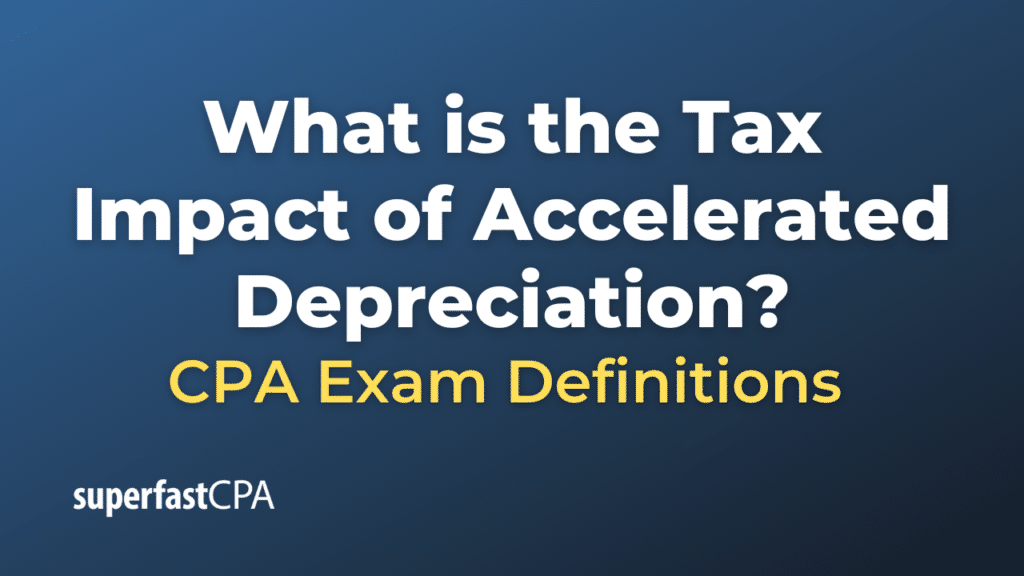Tax Impact of Accelerated Depreciation
Accelerated depreciation allows businesses to write off the cost of an asset more quickly than the straight-line method, which spreads the cost evenly over the asset’s useful life. The tax impact of accelerated depreciation can be significant for businesses, especially in the early years of an asset’s life. Here are the primary tax implications:
- Higher Initial Tax Deductions: Accelerated depreciation methods, such as the Modified Accelerated Cost Recovery System (MACRS) in the U.S., allow a larger depreciation expense in the initial years of an asset’s life compared to the straight-line method. This means that a company can deduct more of the asset’s cost from its taxable income earlier, reducing its tax liability in those years.
- Reduced Taxable Income : A higher depreciation expense means a lower taxable income, assuming all other factors remain constant. By reducing taxable income, a business can reduce its tax liability.
- Future Tax Liabilities : While accelerated depreciation can provide tax relief in the early years of an asset’s life, the depreciation expense will be smaller in the asset’s later years compared to the straight-line method. This means that taxable income will be higher in later years, resulting in higher tax liabilities in the future.
- Cash Flow Benefits: The tax savings from accelerated depreciation can improve a company’s cash flow in the early years of an asset’s life. This can be crucial for businesses that need liquidity, especially when they have made significant capital investments.
- Impact on Financial Statements: While the tax impact is a primary concern, it’s also worth noting that accelerated depreciation can reduce a company’s reported net income on its financial statements in the earlier years. This could affect the company’s financial ratios and potentially its perceived financial health, especially if stakeholders don’t take the time to understand the nature of the depreciation method used.
- Potential Tax Policy Changes: The tax benefits of accelerated depreciation depend on prevailing tax laws and regulations. If there are changes to tax policies that impact or eliminate the use of accelerated depreciation, it could affect future tax planning and strategies for businesses.
- Asset Disposal Considerations: If an asset is sold before it’s fully depreciated, there can be tax implications, especially if the sale price is different from the asset’s book value. This is often termed as “depreciation recapture,” where the amount of depreciation taken in excess of the straight-line method is recaptured as ordinary income.
Example of the Tax Impact of Accelerated Depreciation
Let’s illustrate the tax impact of accelerated depreciation with a hypothetical scenario:
Scenario:
Imagine XYZ Manufacturing purchases a new machine for $100,000. The machine has a useful life of 5 years. XYZ Manufacturing has the option to use straight-line depreciation or an accelerated depreciation method. Let’s consider the Double Declining Balance (DDB) method as our accelerated option. Assume the corporate tax rate for XYZ Manufacturing is 30%.
Straight-Line Depreciation:
Each year, XYZ Manufacturing would deduct $20,000 ($100,000 ÷ 5 years) from its taxable income.
Double Declining Balance:
- Year 1: 2/5 of $100,000 = $40,000
- Year 2: 2/5 of ($100,000 – $40,000) = $24,000
- Year 3: 2/5 of ($60,000 – $24,000) = $14,400
- Year 4: 2/5 of ($35,600 – $14,400) = $8,480
- Year 5: Remaining balance = $2,720
Tax Implications:
For the sake of simplicity, assume the only expense XYZ Manufacturing has is this depreciation.
- Year 1:
- Straight-Line: Taxable income reduced by $20,000. Tax saved = $20,000 * 30% = $6,000
- DDB: Taxable income reduced by $40,000. Tax saved = $40,000 * 30% = $12,000
- Year 2:
- Straight-Line: Tax saved = $20,000 * 30% = $6,000
- DDB: Tax saved = $24,000 * 30% = $7,200
Let’s evaluate over the asset’s entire useful life:
Total Tax Savings Over 5 Years:
- Straight-Line: $6,000 * 5 = $30,000
- DDB: $12,000 + $7,200 + ($14,400 * 30%) + ($8,480 * 30%) + ($2,720 * 30%) = $12,000 + $7,200 + $4,320 + $2,544 + $816 = $26,880
Outcome:
- In the early years (specifically Year 1 in our example), the company saves more in taxes using the DDB method compared to the straight-line.
- However, over the entire life of the asset, the total tax saved with DDB is slightly less than the straight-line, because the company gets smaller tax deductions in the later years using DDB.
This example illustrates that while accelerated depreciation methods can offer substantial tax savings in the initial years of an asset’s life, the cumulative tax savings over time might be less compared to straight-line. However, the immediate liquidity provided by the upfront tax savings can be invaluable for certain companies, especially those in capital-intensive industries or startups with significant capital expenditures.













